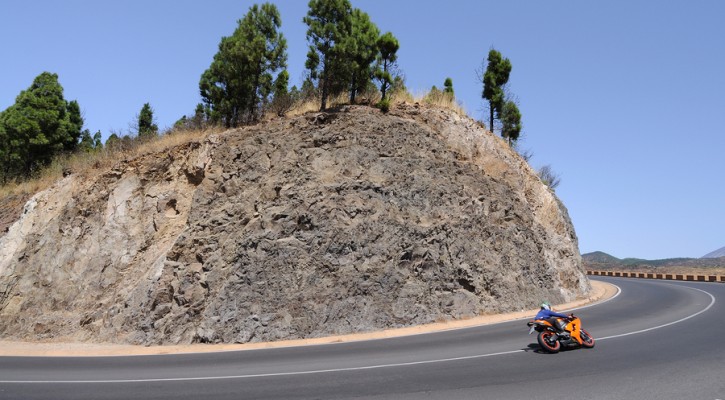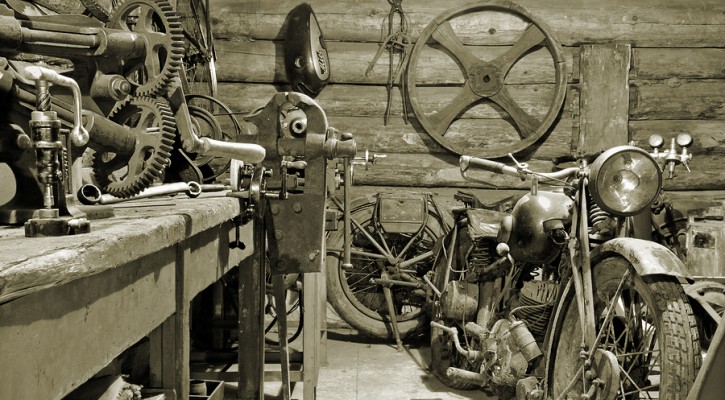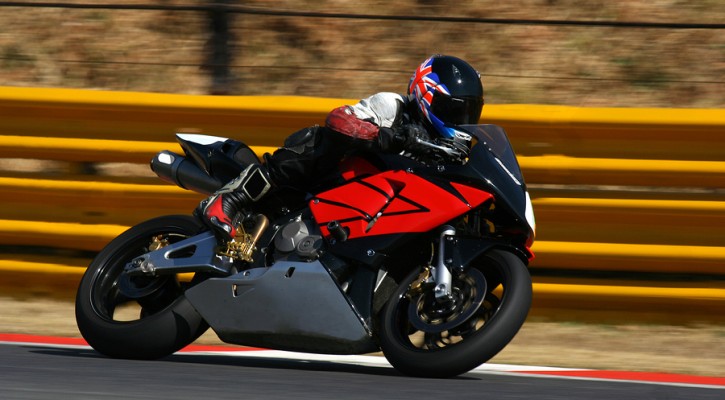Wind Chill
April 13, 2014
With temperatures steadily climbing upwards, it may seem like the perfect time for a ride. However, new riders should keep in the mind the effects of wind chill. For example, 50 degrees may be plenty warm enough to defrost the roads and make for a perfectly pleasant sunny day. However, if you are driving 70 MPH in 50-degree weather, then the wind chill can bring temperatures well down into the thirties. On the other hand, a 70-degree day will have less of a difference when it comes to wind chill, dropping the temperature by just a couple of degrees. So, to figure out how to dress accordingly, we recommend checking out this Wind Chill Index Calculator:

Know Your Limits
April 11, 2014
It’s important for motorcyclists to know what their skill limits are, and to practice pushing their limits in a controlled environment before hitting the road. This article from autoevolution.com stresses the importance of riding within your skill level, and demonstrates the consequences of an over-eager motorcyclist who speeds into a turn, panics, and crashes. See the full story and video here:
http://www.autoevolution.com/news/watch-and-learn-speed-turn-panic-crash-video-78343.html
Motorcycle Security: Protecting Your Ride
April 10, 2014
There are all kinds of thieves in all kinds of neighborhoods. There are professional motorcycle thieves, career criminals looking for a getaway ride, as well as your run-of-the-mill hoodlums in search of a free joy ride. Don’t let your motorcycle fall prey to these bike-poachers. Read these motorcycle security tips and you’re sure to keep those precious wheels safe and sound.
Leave the Title at Home. Don’t store your title on the bike.
Mark your bike. Personalize your bike and then photograph it to make it easier for police to spot in the event of a theft.
Lock it in the Garage. When at home, keep the motorcycle in the garage and lock the door.
Lock the ignition. According to the Motorcycle Safety Foundation, most bike thefts occur when the ignition is shut off, but not locked. So lock your ignition and remove the key.
Lock the forks. Lock the forks or disk brakes with locks that have large, brightly colored tags. (The bright colors will prevent you from forgetting they are there, which could result in an embarrassing situation)
Travel in packs. If riding in a group, motorcycles can be locked together when parked.
Lock to an object. If you’re riding solo, then look for a solid, stationary object that can’t be dismantled such as a rail or light post.
Park in camera’s view. If using a parking lot, parking garage or hotel parking area with security cameras, then locate a camera and park the bike within view.
Get an alarm. This will draw attention to the thieves, and can be triggered if the bike is moved, lifted or flipped. Or, if you’re a cheapskate, you can just get the alarm sticker. Few thieves will take the chance.
Get smart. GPS locators and other hidden devices have been available for some time, and can even be adapted to smartphones, tablets and computers. The latest Scorpio Ride “Core” system can be installed inconspicuously inside the bike and added as an app to your cell phone. The box plugs into the battery and relays information such as location, tire pressure, and even a perimeter check to your phone. In the event of theft, a pin code is made available to share with police so they can track the location.
By using one or all of these security precautions, your motorcycle will be one tough cookie to steal. Never leave that bike out for easy pickin’s and as always, enjoy the ride!

Why Spring is Deadly for Bikers
April 10, 2014
There are several hazards that the spring season brings. For motorcyclists, there are seven, to be precise.
1. Maintenance. Far too many eager riders hop on their bike for the first spring season cruise without performing a proper maintenance check. Remember your T-CLOCS? Tires, Controls, Lights, Oil, Chassis and Stand. Download the Motorcycle Safety Federation’s T-CLOCS inspection checklist to make sure your motorcycle is up for the task.
2. Rusty Skills. Even the most experienced riders need some time to shake off the dust and get back into their motorcycle routines and instincts, and to rebuild the muscle memory that facilitates needed balance and coordination. So, take it easy on your first outing and let your body get used to riding again.
3. Speed. Yes, the first ride of the year is exciting. And, that excitement can unconsciously compel you to roll on the accelerator, hear the engine roar and feel the wind in your hair. However, besides falling victim to a speed trap, this extra acceleration can be dangerous before you’ve gotten back into the swing of things.
4. Drivers. Most drivers haven’t seen a motorcycle on the road all winter. Awareness is especially low in the early spring, leading to more accidents caused by cars turning and changing lanes without double-checking their blind spots.
5. Bikers. That’s right. Other riders can be a danger in the spring season as well. Just like you, they are out of practice and prone to accidents. So, watch out for other motorcyclistst as well.
6. Roads. Rough winters leave roads ridden with potholes, cracks and damage. There is often debris left on the road from floods, and all the road workers and gardeners are hauling gravel, mulch and other materials that can fall on the streets in your route. Hit these hazards on your sport bike, and you’re sure to go down.
7. Weather. Slippery roads are extremely dangerous for motorcycles, and in the spring, rain is as common as wildflowers.
Essential Motorcycle Tools
April 7, 2014
Over at bikebandit.com, there are a lot of great guides for motorcycle enthusiasts. One of the most important guides for those who want save a lot of money is the Buyer’s Guide to Motorcycle Tools. If you don’t already know, motorcycles can be high-maintenance, and learning how to fix and maintain your own bike is rewarding in so many ways. However, before you start any tinkering you will need a decent collection of tools. Get the tool-buying knowledge you need with the complete guide here:
http://www.bikebandit.com/community/guides/the-buyers-guide-to-motorcycle-tools

Motorcycle TLC
April 5, 2014
If you’re bike is a bit on the rickety side, if it coughs and sputters, or if it doesn’t start at all, then it might be time for a little motorcycle TLC. Luckily, there’s a blog post for that. See what the experts at the Allstate Blog have to say about DIY motorcycle maintenance:
Top Ten Tips for New Riders
April 2, 2014
So, you’ve fallen in love with the thrill of motorcycle riding and are ready to dive in. Well, before you begin riding around town on two wheels, there are a few essential tips all new riders should know. So, let us bring them to your attention here and now:
1. Take a motorcycle safety course. Not only will it make you a safer rider – and possibly prevent you from becoming road-ground hamburger meat – it could also make your insurance rates lower. Also, some dealerships offer motorcycle discounts when to take a safety class at their location.
2. Get the right gear. One of the first, and most-often repeated terms you will hear from motorcycle safety experts is wear All The Gear All The Time (ATGATT). Since two wheels are the only thing seperating you from the road, wearing the right equipment is extremely important. 3. Get some tough boots. Boots are shoes that are sturdy will provide better protection for you feet, as well as better balance and control.
4. Don’t get cocky. Never overestimate your skills, and never get overconfident. Riding within your skill level will prevent embarassing and possibly fatal rookie mistakes. If you want to push your limits, then consider taking a class at your local race track to learn the proper throttle, turning and stopping methods for expert riders.
5. Don’t tailgate. Motorcycles may have a shorter stopping distance than cars, however it is not as safe for motorcyclists to slam on the brakes during an emergency. Since they only have two wheels, and often don’t have antilock brakes, it’s easier for motorcycles to lose control when making an emergency stop. So always keep plenty of distance between yourself and other drivers.
6. Always have an escape route. By leaving plenty of room between your motorcycle and other vehicles, you will have more time to react in an emergency situation. Buy yourself even more time by always having an escape route in case of a traffic accident.
7. Mind the weather. Rain, wind, snow and ice are much more dangerous on a motorcycle.
8. Avoid distraction. Part of the joy of motorcycle riding is the rush of a life-or-death state of hyper-alert thinking. Don’t risk your life and cheapen the experience by fiddling with your phone, day dreaming or sipping on a latte.
9. Look twice. Always, always double check before turning, changing lanes or even slowing down. Any changes in your current path may go unseen by other drivers.
10. WEAR A HELMET. This is the main defense in case of an accident, and the only way to keep your face from peeling off on the road if you fly off the motorcycle. Plus, it keeps the bugs and road debris from hitting you in the face while riding.
Now that you’ve heard the 10 essential tips, you’re ready to get started on the path to becoming a motorcycle rider! Enjoy!
Statistics Every Smart Rider Knows
April 2, 2014
There are a few statistics that all motorcyclists should be aware of:
– 3% of vehicle registrations are for motorcycles, while motorcycles account for more than 15% of vehicle fatalities. This staggering statistical combo shows that riders are at a much higher risk of death than any other vehicle.
– Roughly 50% of motorcycle rider deaths occur in crashes involving only the motorcycle. This means that despite all the terrible, distracted and disgruntled drivers out there, the most dangerous person out there is yourself.
– 40% of those fatal crashes happened when the motorcycle operator rode after drinking.
The main lesson from the statistics is obvious: Always ride smart, which means being safe, hyper-aware and sober.

High Speed Training
March 31, 2014
After you have finished your initial motorcycle training, taken classes in the Motorcycle Safety Foundation school, and received your motorcycle license, you might feel like you know it all. Not even close. You know nothing.
The next step in rider education is to experience riding at highways speeds and surviving disasters. Even after years of experience, many riders find that they are still learning, still crashing, and still have much to learn. Rather than risking your life learning these hard lessons on the road, try a weekend class in the RideSmart program to perfect your motorcycle skills.
RideSmart is a very real, hands-on school that teaches riders everything they need to know about riding a motorcycle – from street skills to racing skills. By providing high-speed training on a private track, RideSmart trainers teach motorcyclists how to perfect the art of throttle control, braking, turning and everything else they need to know to ride like a pro. It’s a great way to continue your education in a safe, controlled environment.
